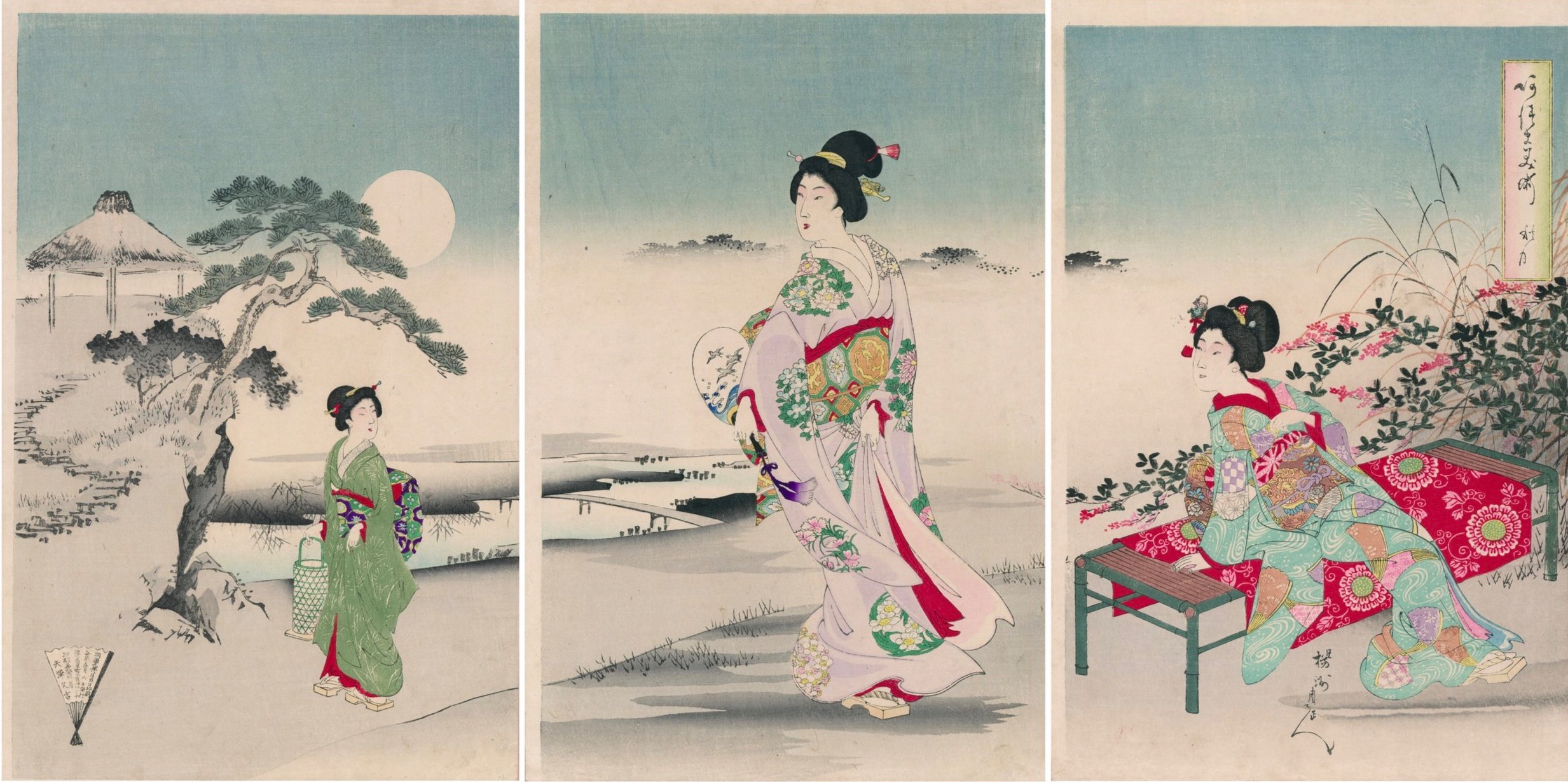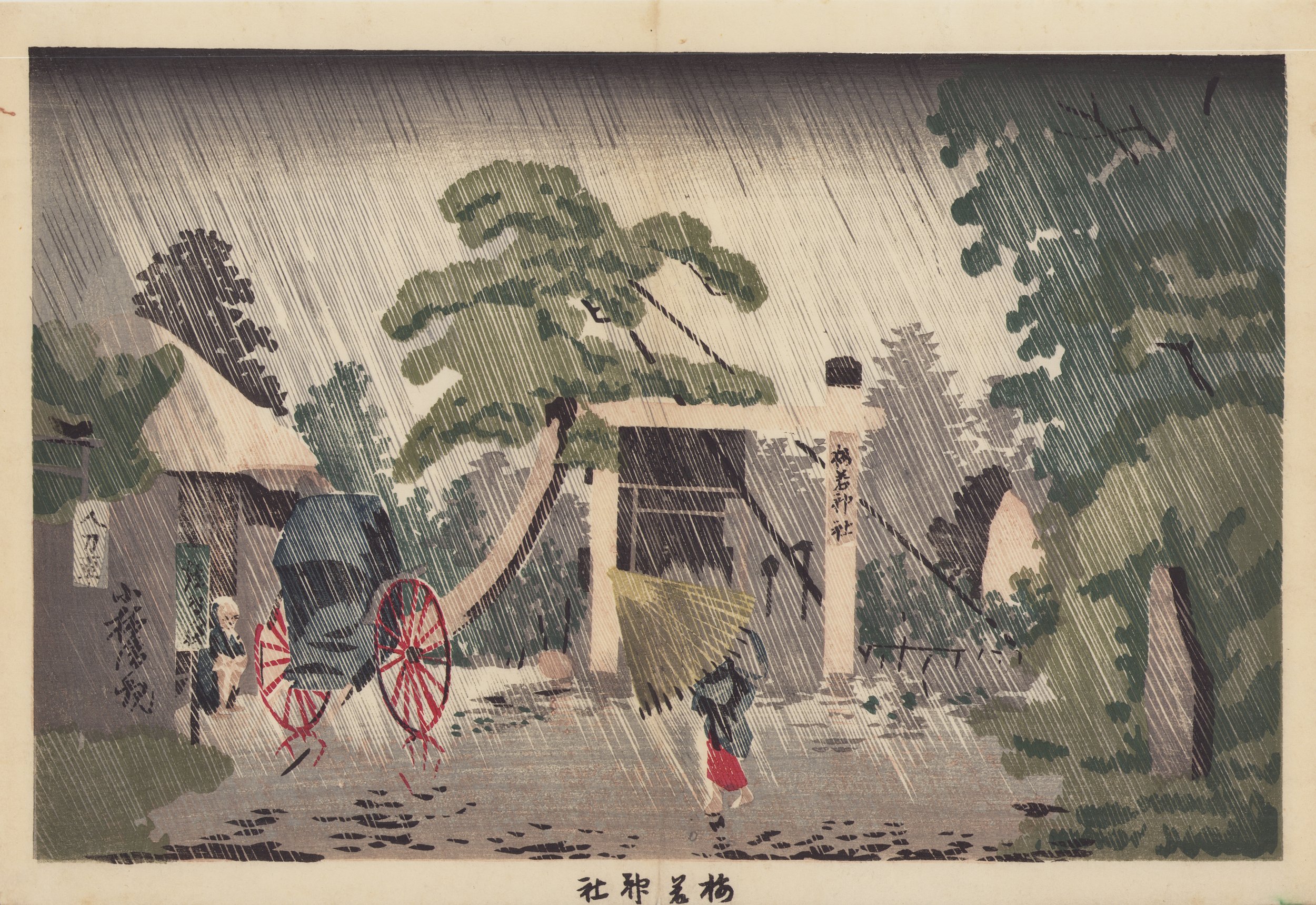Other Ukiyo-e Artists: Meiji (1868–1912)
Toyohara Chikanobu (1838-1912)
Toyohara Chikanobu was born in 1838 in Edo and, obviously possessing talent, studied the Kanō school of painting. But his love was Ukiyoe. He studied with Kuniyoshi and, upon the master’s death, with Kunichika.
A samurai like his father, Chikanobu fought on the side of the Shogan against the Emperor Meiji as Japan moved unsteadily towards modernity, and was arrested when the Emperor’s forces triumphed. But by the 1880s he was free to pursue his art.
His work ranged from Japanese mythology to battles to women's fashions. A great many were triptychs, and some were quite garish in their choice of colors, as was the style in the waning days of Ukiyoe. His designs illustrating women’s fashion were especially interesting because they depicted the radical shift from traditional to Western clothing during the Meiji restoration and the changes in coiffures and make-up styles that accompanied them. When he drew women in traditional dress, it was a nod to the recent past, with a healthy dose of nostalgia. He died in 1912.
Toyohara Kunichika (1835–1900)
Toyohara Kunichika’s father ran a bathhouse, and there’s a good deal of sly humor and energy in his son’s work, whether it be in his depictions of historical scenes, beautiful women — bijin — or a gaggle of naked beautiful women cavorting joyously in, yes, a bathhouse.
But without a doubt, Kunichika’s most important genre was yakusha-e, woodblock prints of kabuki actors and scenes from popular plays.
A student of Kunisada, Kunichika worked in both the Edo and Meiji periods and produced more than 120 series for more than 100 publishers. He was fascinated by examples of Western art then being seen for the first time in Japan. Andreas Marks, in his fine book, “Japanese Woodblock Prints,” notes that Kunichika often placed his scenes within frames as if they were oil paintings. And so it was a great honor when he was asked to contribute to the world exhibition in Paris in 1867, at the very dawn of Modern Japan.
Kobayashi Kiyochika (1847-1915)
Perhaps no Japanese woodblock print artist bridged the Edo and Meiji eras as well as Kobayashi Kiyochika. While some of his notable designs, especially his bijin or “beautiful women” prints, harkened back to the classic days of Ukiyoe, his later work documented the rapid modernization and Westernization of Japan. Indeed, he experimented — at times more successfully than others — with depicting light and shade in the manner of Western art.
Born in 1847, and apparently self-taught, his first known prints date from the 1870s and are rampent with signs of modernization — red brick buildings and trains proliferate. Then he took a step back, creating “100 Famous Views of Musashi,” a modern homage to Hiroshige and the beauty of then-vanishing traditional Japan. After this he mysteriously disappeared from the scene before emerging to focus on dramatic war scenes and more views of fast-evolving Tokyo. Later, he worked as a newspaper illustrator. He died in 1915, having travelled through time.
Yosai Nobukazu (1872-1944)
Yosai Nobukazu had a front row seat to the changes that swept Meiji Japan at the end of the 19th Century, and he depicted them energetically so the world could marvel.
Born in 1872, just after the Meiji Restoration led to the end of the 250-year Shogunate, he is perhaps the best-known student of Yoshu Chikanobu. In his graceful and colorful – and highly romanticized -- triptychs of court ladies the master’s influence is quite evident.
But in those turbulent times, the subtle joys of a life in court were not the order of the day. Japan went to war, first with China and then with Russia, and the public hungered for images of furious battles on land and sea. Yosai was among those Ukiyoe artists who, finding their livelihoods threatened as woodblock prints lost favor, were happy to oblige. They turned their talents to propagandic and often fantastical war scenes.
But like so many Japanese woodblock print artists, he shouldn’t be pigeonholed. Yosai also produced numerous designs depicting the joys of life in Tokyo in that era, just as Western influences began to be commonplace. And he died in 1944, just before so much of his beloved Tokyo was destroyed by Allied bombings in World War II.


















